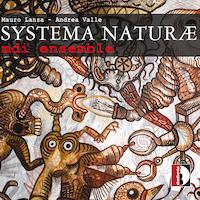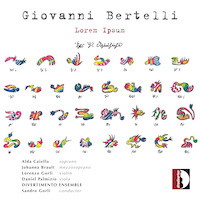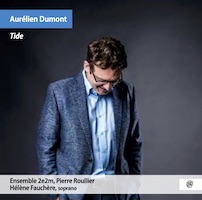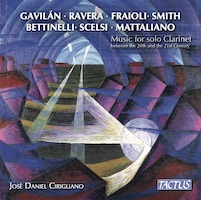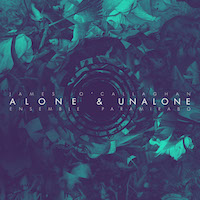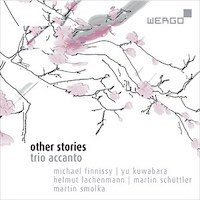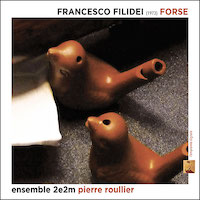Ramble with Hair Dryers, Crumbs and Puccini’s Rifle
|
Grant Chu Covell [February 2022.]
“Systema naturæ.” Mauro LANZA and Andrea VALLE: Regnum animale (2013); Regnum vegetabile (2014); Regnum lapideum (2016); Fossila (2017). mdi ensemble. Stradivarius STR 37138 (1 CD) (www.stradivarius.it). These four pieces introduce a joint composition between Lanza and Valle for instruments plus electronic and mechanical gadgets, creating an invented universe of imagined animals, plants and minerals. Toys, kitchen gadgets and broken machines combine with non-standard instrumental sounds. Regnum animale’s instrumental lineup includes a string trio, recorded closely. Regnum vegetabile adds a wind trio (flute, oboe clarinet) to the trio, and computer-controlled hair dryers breathe into wind instruments (recorders, harmonicas, etc.). The strings scratch, the winds wheeze, and the mechanical devices stumble alive. Regnum lapideum changes the humans (violin, viola, flute, sax, guitar, piano and percussion) and adds noises set into motion with computer-triggered electronics. Fossila employs the full ten-person ensemble. The series grows less whimsical as it evolves. As it happens, the individual sections within each kingdom grow longer too.
“Lorem Ipsum.” Giovanni BERTELLI: Lorem Ipsum (2012)1; Amare, Madre (2009)2; Libro d’Estate (2009-16)3; Cascando (2011)4; Forse son proprio vermi (2016)5. Alda Caiello1,5 (sop), Johanna Brault2 (m-sop), Lorenzo Gorli4 (vln), Danel Palmizio3 (vla), Divertimento Ensemble1,2,3,5, Sandro Gorli (cond.). Stradivarius STR 37085 (1 CD) (www.stradivarius.it). Bertelli (b. 1980) adroitly juggles sense and nonsense. Across Lorem Ipsum’s five parts, a soprano and a chamber ensemble equipped with goofy percussion (toys, car horns, a continually retuning timpani) become overrun by electronic samples (mostly gibberish) and ghostly flickers of Machaut. Texts are frustrated syllables. Pier Paolo Pasolini’s Alla mia nazione receives a more traditional setting in Amare, Madre, but Raffaella Petrosino’s Forse son proprio vermi requires an acrobatic soprano and makes for astonishing drama. Bertelli is fond of treble textures, such as bubbling piccolo and bassoons at their register’s acme. Libro d’Estate is a viola concerto, playful with Stravinskian wind writing and spare rhythms. Beethoven’s Farewell motif (from the Sonata No. 26 in E-flat, Op. 81) appears in various guises. The electronic aspect of the brief Cascando provides darker sounds against solo violin.
“Tide.” Aurélien DUMONT: Flaques de Miettes (2008; rev. 2018); Âpre bryone (2009; rev. 2018)*; Baïnes (2017). Hélène Fauchère* (sop), Ensemble 2e2m, Pierre Roullier (cond.). NoMadMusic NMM081 (1 CD) (www.nomadmusic.fr). It’s all quite delicate, and never obvious: How does the ensemble supply the endless non-standard sounds (breathing, tapping, harmonics, etc.)? What do these itty melodic ideas, these small swatches of textures, actually mean? Flaques de Miettes (“Puddle of crumbs” – Please pause and marvel at the title!) embraces ten mini movements (flute, clarinet, horn, trumpet, trombone, percussion, harp, string trio, contrabass) to be played in any order (Nos. 7, 8, 9, 10, 1, 2, 3, 4, 5 and 6 here) but nearly impossible to discern. Âpre bryone obscurely sets Emily Dickinson over an ensemble including electronics and electric guitar (soprano, flute, clarinet, trumpet, trombone, percussion, electric guitar, harp, string quartet, contrabass, and electronics). Baïnes can be accompanied by Jennifer Douzenel’s videos or not (saxophones, clarinet, bass trombone, percussion, harp, piano, accordion, string trio, and contrabass). There are four “images”: Mascaret, Hong Kong, Blink, and Jupiter. Each grows successively shorter almost by half, as if an argument slimming down, but no, it’s elusive regardless of duration.
“Music for solo Clarinet between the 20th and the 21st Century.” Guido López GAVILÁN: Clariloquio (2008). Alessandra RAVERA: La scatola del tempo (2006). Antonio FRAIOLI: Quattro pezzi (2012); I miei occhi (2017). William O. SMITH: Meditations (1990); Five Pieces (1959). Bruno BETTINELLI: Studio da concerto (1971). Giacinto SCELSI: Ixor II (1954). Giovanni MATTALIANO: Zeta World (2011). Josè Daniel Cirigliano (clars). Tactus TC 930002 (1 CD) (www.tactus.it). Invitingly recorded, with great immediacy and clarity. The bass clarinet pieces, Ravera’s La scatola del tempo and Scelsi’s gangly Ixor II, are gripping. Gavilán’s Clariloquio is predominantly energetic with a contemplative center (slow tones, including breathing) and tosses sly hints at some of the literature’s most famous clarinet solos. Fraioli’s I miei occhi asks the clarinet to play towards left, center or right to dramatize the composer’s fraught experience with a detached retina. The Four Pieces are brighter miniatures. Smith, who worked with Nono, et al, discovered new performance techniques for the instrument. Meditations is played on the lower half of the instrument (demi-clarinet) and includes readings from Marcus Aurelius. The clarinet becomes a less resonant instrument, but still flexible and capable of multiphonics and virtuosic effects. From decades earlier, the Five Pieces are terse and lively. Bettinelli’s Studio da concerto is a forgotten classic, having incorporated several of what are now common extended techniques (multiphonics, quartertones, etc.). Mattaliano’s Zeta World zips by as a perky concluding encore suggesting an extract from Ligeti’s wind Bagatelles.
“Alone and unalone.” James O’CALLAGHAN: subject / object (2016); On notes to selves (2016); AMONG AM A (2015); Alone and unalone (2019). Ensemble Paramirabo: Jeffrey Stonehouse (fl), Victor Alibert (cl), Geneviève Liboiron (vln), Viviana Gosselin (vlc), Daniel Áñez (pno), David Therrien-Brongo (perc). Ravello RR8020 (1 CD) (www.ravellorecords.com). Perhaps singly these four pieces might impress more. They are gritty, lively and pleasantly unfathomable. Each adds electronics to flute, clarinet, percussion and piano trio (an alto flute or bass clarinet may be swapped in), and each tries a different strategy to situate its audience. subject / object reinvents an earlier electroacoustic work which had devolved piano sounds. On notes to selves incorporates site recordings from its performance venues, players reacting to the specific acoustics of the concert space. The electronics in AMONG AM A add non-musical asides similar to the extramusical effects Mingus contributed to his Better Git it in your Soul. Alone and unalone may be the most intriguing, though ironically, this recording can’t represent a concert performance: Audience members are outfitted with individual headphones so that each attendee hears the ensemble as well individually directed sounds. Alone and unalone dramatizes the inescapable fact that we may attend the same concert, but we each hear different things. There are videos of these pieces, however, seeing the players at work subtracts much of the mystery.
“Other Stories.” Helmut LACHENMANN: Sakura mit Berliner Luft (2008)*; Marche fatale (2016/17); Berliner Kirschblüten (2016/17); Sakura-Variationen (2001)*. Martin SCHÜTTLER: xerox (2003; rev. 2016). Yu KUWABARA: In Between (2018). Martin SMOLKA: fff (Fortissimo feroce Fittipaldi) (2010). Michael FINNISSY: Opera of the Nobility (2017). Trio Accanto: Marcus Weiss (sax), Nicolas Hodges (pno), Christian Dierstein (perc), Helmut Lachenmann* (voice). Wergo 7393 2 (1 CD) (www.wergo.de). Lachenmann is insidious as ever, don’t let these somewhat tonal pieces trick you. Disquiet lurks in various variations on a Japanese children’s song and in the piano version of Marche fatale. With dissonance or invented sounds, the ironic gestures can be harder to spy, but Lachenmann has always worked with thwarting expectations, whether appropriating a lounge act or subverting a chord progression. The Marche fatale is a catchy, tonal sequence, with quotations, that might delight an audience expecting easy tonality, but listen close and despite the welcome cliches, the piece runs aground, defying a conventional finish. The other works were written specifically for Trio Accanto. Schüttler’s xerox matches the trio to a tape of distant recordings. Kuwabara’s In Between makes bold use of the sax’s ability to swoop and slide. True to its title Smolka’s fff explodes in a volley of percussion and fast piano glissandos. A description might suggest Finnissy’s Opera of the Nobility is the most straightforward, movements that offer faster patterns alternate with coarse settings of arias by Hasse and Porpora, but like Lachenmann, Finnissy is rewriting history.
“Forse.” Francesco FILIDEI: Concertino d’Autunno (2007); L’Opera (forse) (2008-09); Puccini alla caccia (2006). Ensemble 2e2m, Pierre Roullier (cond.). L’empreinte digitale ED13247 (1 CD) (www.empreintedigitale-label.fr). The Concertino specifies recorder, violin and 5 musicians. However, the sounds are predominantly toys, whistles and noise makers which form a foundation of gentle tapping and cooing. The eponymous Vivaldi concerto hides beneath, and sometimes the violin blurts out a familiar gesture, but we mostly hear light fidgeting, a whispered approximation of a country landscape in fall. Likewise, the eight sketches, L’Opera (forse) which interleaves texts by Pierre Senges (the narrator here), asks for six musicians who play toys, rattles, bells and other miscellany. The French text makes fun of the pastoral genre and gradually introduces us to an impossible romance between a bird and a fish. They are finally brought together after having been hunted. There is a brief requiem setting, and the last sketch is a recipe which combines them. Finally, the brief Puccini portrait alternately silly and sinister requires eight people playing bird calls (and a pop-gun).
Bertelli, Bettinelli, Dumont, Filidei, Finnissy, Fraioli, Gavilan, Kuwabara, Lachenmann, Lanza, Mattaliano, O'Callaghan, Ravera, Scelsi, Schuttler, Smolka, Valle, WO Smith
[More Grant Chu Covell, Rambles]
[More
Bertelli, Bettinelli, Dumont, Filidei, Finnissy, Fraioli, Gavilan, Kuwabara, Lachenmann, Lanza, Mattaliano, O'Callaghan, Ravera, Scelsi, Schuttler, Smolka, Valle, WO Smith]
[Previous Article:
Constructing Absurdities and Monstrosities: Mikel Urquiza]
[Next Article:
Mostly Symphonies 40.]
|
